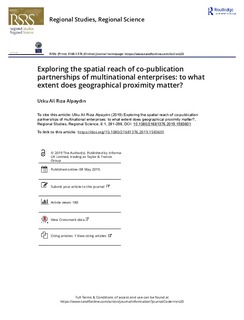| dc.contributor.author | Alpaydin, Utku Ali Riza | |
| dc.date.accessioned | 2019-08-21T11:05:48Z | |
| dc.date.available | 2019-08-21T11:05:48Z | |
| dc.date.created | 2019-02-27T13:32:28Z | |
| dc.date.issued | 2019-05 | |
| dc.identifier.citation | Alpaydin, U.A.R. (2019) Exploring the Spatial Reach of Co-publication Partnerships of Multinational Enterprises: To What Extent Does Geographical Proximity Matter? Regional Studies, Regional Science. 6 (1), pp. 281-298. | nb_NO |
| dc.identifier.issn | 2168-1376 | |
| dc.identifier.uri | http://hdl.handle.net/11250/2609484 | |
| dc.description.abstract | There is an increasing interest in defining the determinants of university-industry collaborations (UICs). One recent tendency is to embrace the proximity approach while explaining the process of coordination in UICs. Most studies generally take on the role of geographical proximity and try to explain its effects by looking at the universities. These studies try to identify the firms that universities collaborate with and define the determinants of these collaborations in line with the firm characteristics. However, this paper, rather than taking universities as the main unit of analysis, takes a firm-centric approach and examines the co-publication collaborations of a multinational enterprise (MNE) with universities. The paper explores the spatiality of these collaborations and geographical proximity’s influence on the collaboration networks of MNEs. Using the case study of a multisite multinational enterprise’s co-publications with universities through bibliometric data, it is aimed at providing some refinements about the influence of geographical proximity. The analysis shows that geographical proximity plays a significant role in UICs for MNEs. The findings also indicate that, despite its overall importance, the effects of geographical proximity differ for the branches of the same firm. The collaboration patterns of different units show divergence regarding the share of collaborations at various geographical scales. This suggests that following a more nuanced perspective in UIC studies dealing with geographical proximity may be useful in clarifying its effects. | nb_NO |
| dc.language.iso | eng | nb_NO |
| dc.publisher | Taylor & Francis | nb_NO |
| dc.rights | Navngivelse 4.0 Internasjonal | * |
| dc.rights.uri | http://creativecommons.org/licenses/by/4.0/deed.no | * |
| dc.subject | university-industry collaboration | nb_NO |
| dc.subject | multinasjonale selskap | nb_NO |
| dc.subject | geografisk nærhet | nb_NO |
| dc.title | Exploring the Spatial Reach of Co-publication Partnerships of Multinational Enterprises: To What Extent Does Geographical Proximity Matter? | nb_NO |
| dc.type | Journal article | nb_NO |
| dc.type | Peer reviewed | nb_NO |
| dc.rights.holder | © 2019 The Author | nb_NO |
| dc.subject.nsi | VDP::Social science: 200 | nb_NO |
| dc.source.pagenumber | 281-298 | nb_NO |
| dc.source.volume | 6 | nb_NO |
| dc.source.journal | Regional Studies, Regional Science | nb_NO |
| dc.source.issue | 1 | nb_NO |
| dc.identifier.doi | 10.1080/21681376.2019.1583601 | |
| dc.identifier.cristin | 1681038 | |
| dc.relation.project | EC/H2020/722295 | nb_NO |
| cristin.unitcode | 217,14,1,0 | |
| cristin.unitname | Avd. for innovasjon, led. og mark.føring | |
| cristin.ispublished | true | |
| cristin.qualitycode | 1 | |

